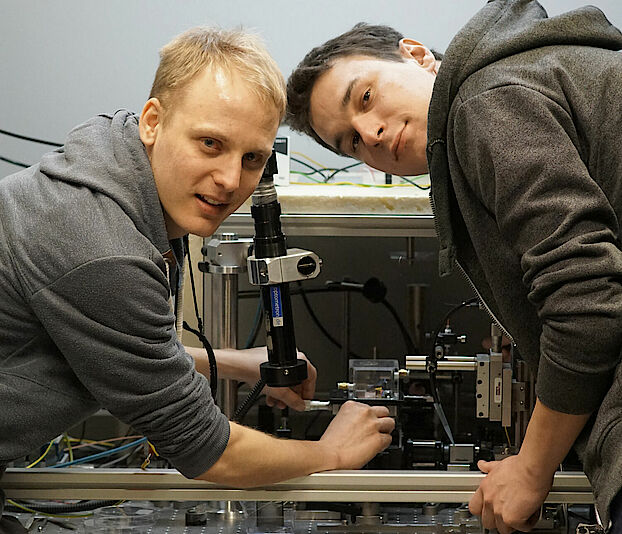/ Erfolgsgeschichten
Faster analysis with tiny quantities
MiPIS Argovia project optimizes sample preparation for cryo-electron microscopy
In 2017, the Nobel Prize in Chemistry was awarded to Professor Jacques Dubochet, Professor Joachim Frank, and Professor Richard Henderson. They received the prestigious science prize for the development of cryo-electron microscopy (cryo-EM). Thanks to this method, it is now possible to create 3D images of complex proteins in their natural environment at atomic resolution. Cryo-EM has become an established standard for protein analysis and has revolutionized structural biology and biochemistry. However, existing methods of protein isolation and preparation are not necessarily geared toward the needs of cryo-EM. In the MiPIS Argovia project, therefore, an interdisciplinary team led by Dr. Thomas Braun (C-CINA, Biozentrum) is working to develop an ideal, rapid, microfluidic technique. The scientists aim to have protein samples cleaned, stabilized, and prepared for cryo-EM analysis within two hours while preserving their three-dimensional structure.
Cryo-EM has been the method of choice for years
For many years, the cryo-electron microscope (cryo-EM) has been at the heart of research by Professor Henning Stahlberg and Dr. Thomas Braun from the Center for Cellular Imaging and Nano Analytics (C-CINA), which is operated by the University of Basel’s Biozentrum. Together with their teams, the scientists have focused on studying the molecular mechanisms behind the development of neurodegenerative diseases and on characterizing membrane proteins. They use a variety of imaging techniques in their work. Today, thanks to cryo-EM in particular, the researchers are able to generate precise images of the three-dimensional arrangement of complex proteins at atomic resolution. These detailed images are the first step toward understanding diseases and identifying potential targets for active pharmaceutical ingredients.
Adjustments needed
However, the classic methods of preparing proteins are not always appropriate for the requirements of cryo-EM because they are time-consuming, involve relatively large quantities of protein, and partly disrupt the spatial arrangement of the protein complexes. To simplify and improve the analysis of proteins, the scientists from C-CINA are therefore also developing new methods of isolating and processing proteins, which can then be analyzed using cryo-EM.
As the identification of proteins’ three-dimensional structures only requires cryo-EM images of between 100,000 and a few million protein particles, the scientists in the MiPIS Argovia project are focusing on microfluidic systems, which they hope will deliver significant advantages over the classic methods. A microfluidic system has already been developed at C-CINA as part of other SNI projects. This system requires just a few nanoliters of sample material, which is placed directly on one of the slides used for electron microscopy in a fully automated process. In the MiPIS Argovia project, the aim is now to refine this system so that it can clean, stabilize, and prepare proteins for cryo-EM analysis within two hours while preserving their three-dimensional structure. Alongside project leader Dr. Thomas Braun, those involved in the work include Dr. Mohamed Chami from the BioEM Lab (C-CINA), Professor Marianne Hürzeler from the School of Life Sciences at the University of Applied Sciences Northwestern Switzerland (FHNW), and Professor Michael Hennig and Dr. Mathieu Botte from the start-up leadXpro (Villigen, Aargau).
Held in place with magnets
“We’ve managed to expand our existing platform so that we now have a quick and reliable method at our disposal,” says Thomas Braun. In order to isolate proteins from an untreated cell lysate, the first step in the process is to functionalize superparamagnetic particles with antibodies that bind to the protein being analyzed. When these particles are mixed with the cell lysate, the proteins bind to the antibodies and are therefore connected to the tiny magnetic particles. In a microcapillary, the proteins can then be immobilized using a magnet, separated from other components of the cell lysate, and washed. Using UV light, the proteins are then disconnected from the paramagnetic particles and the antibodies bound to them and are ‘written’ directly onto the slide with the microcapillary.
Now, a special electron microscope slide is covered with a perforated carbon film and placed on a platform whose temperature is kept near dew point. The microcapillary used to clean the protein sample is placed above the slide. A few nanoliters of the suspension are applied to the slide, and the platform is moved slightly in order to distribute the sample evenly. While the microcapillary is removed from the slide, the sample remains on the temperature-controlled platform for a short time and is concentrated in a controlled manner via evaporation. The scientists then quickly plunge the slide, along with the applied sample, into liquid ethane. This rapid freezing process causes the water present in the sample to solidify into amorphous ice and therefore to exhibit glass-like properties. This process does not produce crystals, which would destroy the protein structure. Known as vitrification, this step in the cryo-electron microscopy technique was developed by Swiss Professor Jacques Dubochet, who was awarded a Nobel Prize for this groundbreaking innovation.
The whole sample preparation process takes place automatically and requires only around 3 to 15 nanoliters of liquid, whereas conventional methods operate with sample volumes of 3 to 5 microliters. With conventional methods, it generally takes scientists several days to obtain cleaned proteins from the cell lysate and prepare them for cryo-EM analysis. The team behind the MiPIS Nano Argovia project now achieves this in under two hours thanks to the new microfluidic system.
“We’ve managed to develop an almost lossless method,” says Thomas Braun. “Whereas, in classic preparation methods, far larger quantities of proteins are required and the majority of the sample is lost, we just need small sample volumes. Moreover, the proteins are only exposed to air for a very short time, which prevents damage due to drying.”

